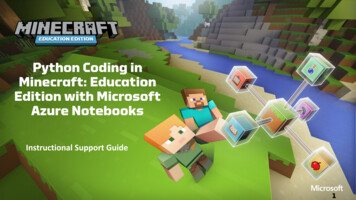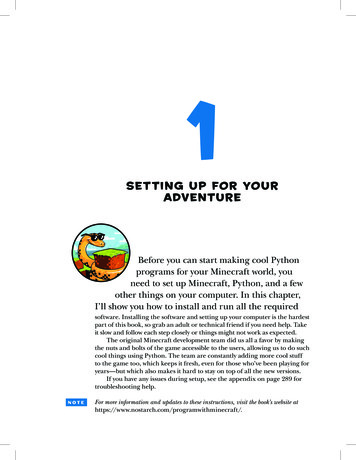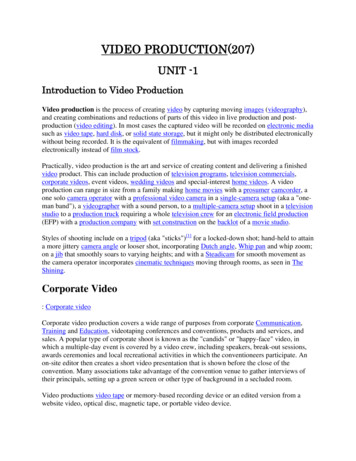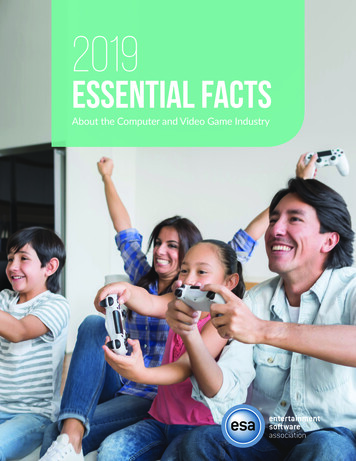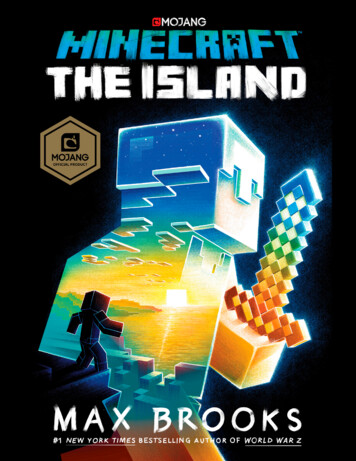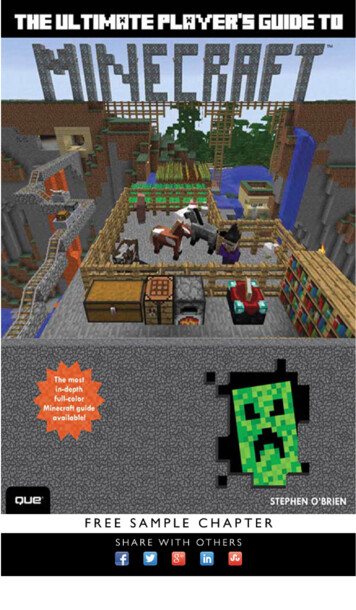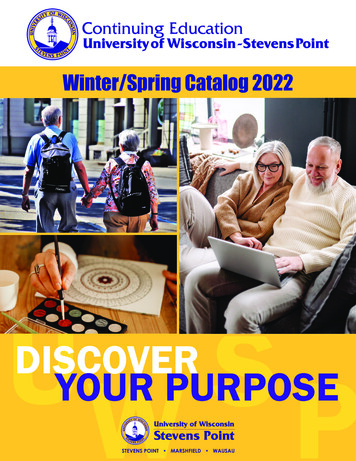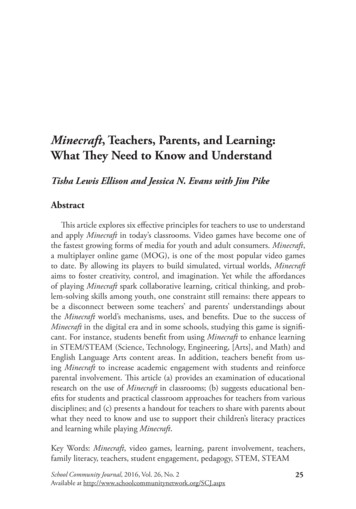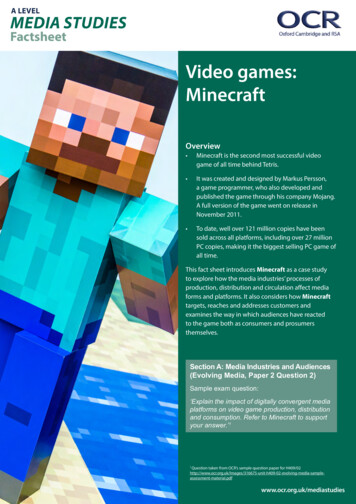
Transcription
A LEVELMEDIA STUDIESFactsheetVideo games:MinecraftOverview Minecraft is the second most successful videogame of all time behind Tetris. It was created and designed by Markus Persson,a game programmer, who also developed andpublished the game through his company Mojang.A full version of the game went on release inNovember 2011. To date, well over 121 million copies have beensold across all platforms, including over 27 millionPC copies, making it the biggest selling PC game ofall time.This fact sheet introduces Minecraft as a case studyto explore how the media industries’ processes ofproduction, distribution and circulation affect mediaforms and platforms. It also considers how Minecrafttargets, reaches and addresses customers andexamines the way in which audiences have reactedto the game both as consumers and prosumersthemselves.Section A: Media Industries and Audiences(Evolving Media, Paper 2 Question 2)Sample exam question:‘Explain the impact of digitally convergent mediaplatforms on video game production, distributionand consumption. Refer to Minecraft to supportyour answer.’1Question taken from OCR’s sample question paper for 1www.ocr.org.uk/mediastudies
Key termsDigitally convergent media: Video games consoles arean excellent example of a digitally convergent device,you can not only play games but access social media,surf the internet, stream films and TV content and uploadcontent into cloud based servers. Cross-media contenthelps maximise profits and also improve reach to newcustomers.Distribution: This refers to all processes linked todelivering the media product to audiences both throughtangible (disc) and digital (Cloud based) media.Consumption: Explores the way in which the media textis used by audiences for pleasure but also explores therise of user generated content across several platforms.Production: This refers to all phases of designing,developing and making the media product; this process isaddressed in this factsheet.Media industriesA recent report by the UKIE suggests that the globalgames market is now worth in excess of US 100 billiona year, with projections estimating revenue of US 120billion by 2020 after a pattern of continued growth. TheUK’s share of the market is just over US 4 billion; China,the fastest growing sector, currently enjoys US 24.4 billionversus America’s US 23.6 billion.In comparison to traditional media like film, radio,print and television, video games are much younger,exponentially growing since the 1970s. This era wasreferred to as the golden age of the video games industry,peaking between 1978 and 1983 when the combinedrevenue of US arcade and home videogames was worthsome US 11.8 billion - a sum that far outstripped theFor full details see www.ocr.org.uk/mediastudiesprofits of the American movie and music industriescombined. However, rival consoles, poorly designedgames and a lack of quality control meant that the marketcrashed heavily; by 1985 the games console industry inthe US was estimated to be worth just US 100 million.Over three decades later, the industry is enjoying aresurgence with new types of ‘gamer’ and much tighterregulation, aided by key developments in internet speedsand accessibility. Thus, video games are culturally andfinancially significant across major territories (includingJapan, Europe and the USA) with new console andgames releases from popular franchises classed as majoreconomic events. OCR 2017
MinecraftMinecraft is a sandbox game, created and developedby Swedish based Mojang Studios. The game hasbeen described as a virtual world of Lego that involvesfollowing simple instructions in order to play it: explore,mine and build. Users only have to log in and proceedto create a world full of textured 3D cubes. There arepredominantly two game modes: Creative or Survival,although more recent additions include Adventure,Spectator and also Multi-Player modes.Minecraft’s Swedish creator, Markus “Notch” Perssonstarted creating the game in May of 2009 having beeninspired by similar games such as Dwarf Fortress, a singleplayer construction and management game; his goal wasto produce a RPG variation of such a game. Minecraft’sinitial reception wasn’t commercially viable, seen moreas a niche product for players with expert knowledge ofcomputers and programming.Without the commercial backing of a mainstreampublisher, and no money spent on advertising revenue,the game relied on word of mouth between gamers andfeatured on sites such as the Penny Arcade web comicto generate interest amongst gamers. Consequently, byJanuary 2011, the beta-version of the game had passedover one million purchases in just only a month, andby April 2011 Persson estimated that US 33 million ofrevenue had been made.In November 2011, prior to the game’s official release,Minecraft had over 16 million registered users and4 million purchases. Due to its popularity, Minecraftwas released across multiple platforms becoming acommercially viable franchise with increased interactivity.In particular, Minecraft: Pocket Edition was released onSony Xperia Play, available on Sony Xperia smartphones.Minecraft also become available on Android and iOSdevices shortly after.For full details see www.ocr.org.uk/mediastudiesFormats: By 2012, Minecraft was available for Xbox360 and Xbox Live. In 2013, Minecraft: Pi Edition, meantfor educational purposes for novice programmers andplayers, was also released. In 2014, Microsoft acquiredMinecraft intellectual property for 2.5 billion. In 2015, itreached 30 million copies sold. To date, over121 official copies of the game have been soldacross a variety of formats and platforms.Distribution: Versions of the game canbe purchased over the internet using such outletsthe Playstation Network or Xbox Live Arcade. Recentadditions include the Nintendo platform which wasexcluded from the initial Minecraft releases; available todownload from December 2015 with physical copiesfrom June 2016 and most recently for Nintendo Switch(May 2017) and Nintendo 3DS (downloadonly from September 2017). The Minecraft:Story Mode - A Telltale Games series is alsoavailable via Steam.Critical reception: On its release, the game won fiveawards at three conferences, including an InnovationAward, Best Debut Game, Best Downloadable Game,Audience Award and Seumas McNally Grand Prize.Genre - Sandbox game: A game free of structure andconstraint; players are free to roam and make choicesabout how they use available content.Sandbox games are often described as havingopen world settings. Minecraft later createda hybrid genre with the story versions and issometimes categorised as sandbox, survival. OCR 2017
Processes of production,distribution and circulationby organisations, groups andindividuals in a global contextHere are some key points to consider. There is a varietyof links at the end of this worksheet used to support theconstruction of this resource and with references that cansupport the teaching of the following:The specialised and institutionalised nature of mediaproduction, distribution and circulation.Here you could consider how video games havedeveloped as a medium. There are several documentariesand fan-made videos shown online which comparesthe types of games and their evolvement over the years,including the improvement of graphics and capabilitiesof modern games. Ironically, it is the simplistic nature ofMinecraft and its blocky, universal nature which seems tohave maximum appeal across a range of audiences.It is worth considering how a simple PC Java game hasbecome a globally successful phenomenon across allconsoles and hand-held devices; Minecraft is now a multiplatform game which is not only just for PC gamers butthose who own smartphones, Microsoft consoles (Xbox);Playstation 3, 4 and PS Vita; and more recently Nintendoconsoles (Wii U) and hand-held devices (Nintendo Switchand Nintendo New 3DS, New 2DS XL and New 3DS XL)– all of which opens up new markets of profitability andincreased exposure to new and existing audiences.Modern versions of the game, notably Minecraft: StoryMode, follow more of the recognisable institutionalconventions of game development including tutorials onhow to play the game, something the original Minecraftseries never had.In a global context, the purchase of Mojang by MicrosoftStudios for US 2.5 Billion is a testament to the lucrativeindustry and global appeal of such a game acrossdifferent platforms.The relationship of recent technological change andmedia production, distribution and circulation.Due to the original nature of the game, most playerssimply logged in to play Minecraft and didn’t needa physical copy of the game. When the Xbox andPlayStation versions were created there was oftena chance to offer digital versions of the same gameacross the Windows 10 operating system to promotethe Microsoft brand across home computers, a form ofsynergy. Users were often encouraged to download theFor full details see www.ocr.org.uk/mediastudies OCR 2017
game through the cloud servers rather than a physicalcopy of the game which would incur more of a cost forthe institution. The pattern of release for Minecraft showsthat physical copies are often released six months afterthe downloadable version, most likely as a way to limit theimpact of piracy, hacking and file sharing.The introduction of Minecraft Realms (2013) has tried togive the producers more control over the distribution andcirculation of the game since some pro-am consumerswere creating their own virtual spaces and hacks acrossillegitimate servers, such as https://www.wizardhax.com/play/ as one example. It would be worth considering howsome audiences might be playing Minecraft throughthese channels and are not included in the extensiveofficial user figures.The significance of patterns of ownership andcontrol, including conglomerate ownership, verticalintegration and diversification.You could focus on the developer, Mojang Studios,which is now owned by Microsoft Studios, a division ofthe parent company, Microsoft. Mojang Studios is theironly first-party studio in Europe. Given the nature of theparent company and the loyal fan base of PC gamers, itwas in the company’s interest to invest US 2.5 billion topurchase Mojang for long term revenue.Other collaborations with games developers includes TelltaleGames who helped develop the Minecraft: Story Mode in2015. The Playstation versions were developed by 4J Studios.Other noteworthy soundbites include the offer ofinvestment from former Napster founder and Facebookpresident Sean Parker in 2011, which was declined byMojang. When Facebook bought Oculus in March 2014,Markus Persson was quick to vocalise that he would notbe developing a version of Minecraft with Oculus becauseFacebook was not owned by a group of ‘grassroots’game developers. However, when Microsoft bought outMojang and the intellectual property rights of Minecraftin November 2014 of that year, plans to work on a virtualreality version of Minecraft were renewed; Markus Persson’sstakes in the company were no more. This can sparkinteresting debate about the ideology of game developersand prosumers who often surrender their creative licenseto conglomerate interests to maximise profits.Minecraft is a good example of a game that was madeand developed using readily available open sourcesoftware within the gaming community; creating theoriginal Minecraft using Java gave it the advantage ofbeing cross-platform: it will run on Windows, Mac OS X,and Linux. You can compare this to other mainstreamgames that require entire teams of programmers, artistsand engineers to make video games that have budgetsequal or exceeding that of mainstream films.Minecraft has also been linked to non-profit projects suchas the UNs Block by Block project, which encouragescommunities around the world to redesign theirneighbourhoods using Minecraft. An educational versionhas also been developed, MinecraftEdu (2012), which hasseveral applications to help teach subject and develop aculture of computer programming amongst digital natives.How media organisations maintain, includingthrough marketing, varieties of audiences nationallyand globally.The cultural impact of Minecraft is significant and youcould discuss ways in which much of Minecraft’s successwas due to word of mouth and audiences sharingtheir own mods and game footage across web forumsand video sharing sites such as YouTube. Differentversions of Minecraft were released to entice differentaudiences, moving away from creation only narratives toinclude story modes, spectator modes and multi-playerfunctionality across Minecraft Realms.Further developments included the introduction of aphysical Lego set to encourage younger audiences aswell as merchandise opportunities and bonus contentfor buying more than one version of the franchise acrossplatforms. Culturally, other developers and games studioshave made intertextual references to Minecraft acrossgames such as Runescape and The Elder Scrolls V:Skyrim to name but a few; Lady Gaga, South Park and TheSimpsons have also parodied Minecraft. All of this benefitsthe game by heightening its exposure to audiences.In 2019 there will be a joint venture with Warner Brothersto release Minecraft the movie, this will be anticipated ashaving as much commercial success as The Lego Movie,also a Warner Brothers Movie. No doubt, there will beseveral spin-offs as a result of this.The significance of economic factors, includingcommercial and not-for-profit public funding, tomedia industries and their products.The regulatory framework of contemporary media in theUK and the impact of ‘new’ digital technologies on mediaregulation, including the role of individual producers.With the continued growth of video games you couldfocus on the marketing campaigns for games oftenhaving worldwide and simultaneous releases acrosseach video game market. Budgets for games vary andA link has been included in this worksheet to the UK VideoStandards Council which applies the PEGI rating systemto Minecraft. It is regarded as being family friendly andthe initial Minecraft series was rated a PEGI 7 but the laterFor full details see www.ocr.org.uk/mediastudies OCR 2017
introduction of Minecraft Stories were classified higherbecause narratives and dialogue were being introduced.The ESRB rates Minecraft using different criteria. Youcould consider whether a game such as Minecraft evenneeds regulating and perhaps consider more the impactof freely available, fan-made videos where language andcontent is likely to be more risqué and unregulated bysuch bodies. A direct comparison to similar games andtheir ratings would also fuel debate, e.g. Tetris is a PEGI 3.It is also worth considering how material is accessedand played. Minecraft Realms are hosted on specialisedservers by Mojang. The terms and conditions areextensive and bring into debate issues of ownership ofintellectual content and the disclaimers that now have tobe issued by media industries. Most interestingly, thereare stipulations by the company that they own everythingcreated using blocks within these virtual worlds and thataccreditation for worlds and structures created by fans isnot guaranteed.In 2016 a marketplace was created for communities totrade in maps, skins and texture packs.How processes of production, distribution andcirculation shape media products.Here you should refer to the common generic features ofsandbox games that can be accessed on servers in ‘the cloud’.It is a good idea to compare and contrast similar games.The impact of digitally convergent media platformson media production, distribution and circulation,including individual producers.The nature of the game and development in Java hasmeant that there are several rival and clones to the gameMinecraft. http://castleminer.com/ is just one exampleof a game with remarkable similarities and there is muchscope for debate about how you go about copyrightingideas if everyone is using open source software. Indeed,when Microsoft purchased Mojang there was a surge inclone titles for rival consoles, such as Nintendo (who didnot officially receive versions of Minecraft at the time)including Battleminer for the Nintendo 3DS 3ds Noticethe slight variations in story narrative and the glaringlyobvious similarities. One could argue that Minecraft wassimply the right version of a block building game atthe right time; it also highlights the importance of theemerging portable device market and capitalising onaudience desires.For full details see www.ocr.org.uk/mediastudies OCR 2017
Media audiencesThere are many discussion points to consider whenlooking at audience reception and use of Minecraft.Multiple gameplay modes are now available acrossseveral platforms now that the game is finally availableacross all markets on all consoles and hand-held devices.The PC version of the game was noted for its moddingscene where prosumers would alter the gameplaymechanics, change the assets and develop new skins andtextures for other fans of the game to use.The game is a global and commercial success and alsopraised by several high profile critics and gaming institutions.The game has amassed such a following that MineConconventions can be found all around the world and furthersupport popularising the game. There are other conventionsof the game that have proven popular, including the releaseof albums featuring the music of the game, produced byGerman sound designer Daniel “C418” Rosenfeld.The biggest discussion point for Minecraft should be‘which platform do I play?’ With so many versions andformats available there was no sign of an outright consolewinner despite the game originating for the PC. However,in July 2017 a ‘cross-play’ feature was developed, meaningthere was less emphasis on showing brand loyalty toeither console. Despite audiences possibly owning morethan one device, or a console and hand-held deviceby the same company, there does seem to be a focuson only developing content for the newer devices. Forexample, the recent Nintendo versions are not supportingon the Nintendo 2DS and 3DS, but are on the ‘newer’3DS and 2DS XL and 3DS XL models. This highlights anongoing concern about the proliferation of technologyand sustainability of audiences being able to afford newFor full details see www.ocr.org.uk/mediastudiesconsoles just to play a game (you could consider theexpectation of gamers to invest in VR headsets).There is evidence to suggest that mobile and hand-helddevices are really driving the sales of Minecraft forward.For example, the release of the Playstation Vita version ofMinecraft boosted sales of Minecraft by 79%, outsellingPS3 and PS4 releases and making it the largest launchon a Playstation console. The appeal is being fuelled by anew generation of gamers who prefer hand-held devicesover traditional consoles.The continued development of fan made media acrosssocial media platforms and dedicated fan sites and blogsmeans that there is an active community of gamerswho share a common interest linked to Minecraft. Thiscan include groups such as The Yogcast who regularlyproduce videos that collectively have billions of views.Future conventions are expected to take place online asthe demand and attraction of the game shows no sign ofdeteriorating (November 2017).Fan made clones of the game are now ubiquitous acrossmarket place apps and various merchandise (both officialand fan made) is available to purchase online. A series ofbooks and magazines have also begun to appear after adeal with the Egmont Group.Further applications of the game in the fields of computeraided design (CAD) has seen a cultural impact on theeducation system with MinecraftEdu (September 2012) aswell as partnerships with global charity projects such as theUN’s Block by Block project, an ongoing social experimentto encourage audiences to improve their communities bydesigning utopian worlds using Minecraft. OCR 2017
How audiences are grouped and categorised bymedia industries, including by age, gender and socialclass, as well as by lifestyle and taste.Minecraft has universal appeal. It is useful to explore howsuch a game can appeal to different ages, genders andaudiences from different social and cultural backgrounds.The variety of different modes is certainly a contributingfactor to the game’s success, but also the way in whichaudiences can control and shape their own worlds andcreate new identities through mods and altering textures,maps and craft kits.How media producers target, attract, reach, addressand potentially construct audiences.Minecraft and subsequent versions and variations of thegame offers familiar pleasures to existing fans (narrativefeatures, open world gameplay etc.) along with newelements to target a wider audience (e.g. Story Mode). Thecreation of Minecraft Realms was a well-considered wayto attract and encourage audiences to use the game ondedicated servers and increase subscription revenues.There already exists an established network of fans acrossthe internet who share game footage, tutorials, mods andhacks so that gamers can get new experiences from thegame.How media industries target audiences through thecontent and appeal of media products and throughthe ways in which they are marketed, distributed andcirculated.Initially there was little work to advertise the originalversion of Minecraft; it was simply word of mouth acrossforums that created a buzz about the game. Now thatMinecraft is established and owned by a division of aconglomerate, the methods used to distribute and marketthe game are similar to popular mainstream releases.For full details see www.ocr.org.uk/mediastudiesThe interrelationship between media technologiesand patterns of consumption and response.YouTube, Facebook and online fan communities hasenabled Minecraft’s audience to have an active voice inits ongoing production through detailed feedback andcommentary on modifications and beta tests. There areseveral niche forums that should also be investigatedacross the internet.How audiences interpret the media, including howthey may interpret the same media in different ways.There are now several formats and versions to playMinecraft, however one of the most importantdevelopments has been the introduction of ‘cross-play’which means that players no longer need the sameconsole to play against each other. The developmentof the Minecraft ‘cross-play’ is just one example whichenables gamers (the audience) to experience onlineplay with other Minecraft players at the same time. (July2017, ‘cross-play’ is available across all devices whichcan support Windows 10, iOS, Android, Xbox One andNintendo’s Switch.)How audiences interact with the media and can beactively involved in media production.The establishment of Minecraft Marketplace is a greatexample of the industry listening to their audiences (fans)and allowing the trade of different maps, textures and‘add ons’ in a legitimate setting. The nature of the gamehas also allowed audiences to learn new skills, such asprogramming.There are several prosumers on YouTube and acrossblogs who have their own dedicated channels discussingMinecraft, offering tutorials or who just want to show offtheir gameplay or promote their own maps. OCR 2017
Whilst there is NO REQUIREMENT to directly reference theory forthis question in the exam, you could consider introducing thefollowing theoretical perspectives at A LevelRegulation – Sonia Livingstone and Peter LuntNew technologies (in this case the convergent deviceswith access to internet, Bluetooth, etc.) opens upopportunities and risks that complicate regulation.Cultural Industries – David HesmondhalghExplore how cultural industry companies attempt tominimise risk and maximise audiences. The game hasa large fan base and is owned by a division of a globalconglomerate. The purchase of Mojang for US 2.5 billionillustrates that Microsoft are clearly attempting to harnessthe popularity of this franchise to encourage sales bothof the game itself and promote Windows 10 and theirsmartphone market.Identity – David GauntlettGauntlett conducted a series of studies based aroundthe use of Lego to create and share ideas and has alsoFor full details see www.ocr.org.uk/mediastudiescompared this to how audiences use the internet (onegiant allotment). Making is Connecting is all about howpeople build a stronger sense of self-identity throughcreative practices. Minecraft adopts the same principlesand shows how audiences are not only ‘making andconnecting’ but are infinitely more creative through theuse of the internet. The critical response of Minecraft as amedia text highlights how the game is a way for peopleto socially create and interact is testimony to this idea.Fandom – Henry JenkinsVideo games offer social experiences (online multi-playeroptions) as well as communities outside of the core gameexperience. Jenkins’ key quote ‘if it doesn’t spread, it’s dead’can be used as a discussion point to track the birth andpopularity of the franchise. Minecraft has a strong, welldeveloped fan base that could be researched in more detailin relation to Jenkins’ ideas about participatory culture. OCR 2017
Webography of resourcesconsulted in the construction ofthis lts/search?keywords ook/https://minecraft.net/en-us/marketplace/For regulation see http://videostandards.org.uk/PEGI/index.html versus edia.org/wiki/MojangWe’d like to know your view on the resources we produce. Byclicking on the ‘Like’ or ‘Dislike’ button you can help us to ensurethat our resources work for you. When the email template popsup please add additional comments if you wish and then just click‘Send’. Thank you.Whether you already offer OCR qualifications, are new to OCR, orare considering switching from your current provider/awardingorganisation, you can request more information by completing theExpression of Interest form which can be found here:www.ocr.org.uk/expression-of-interestOCR Resources: the small printOCR’s resources are provided to support the delivery of OCRqualifications, but in no way constitute an endorsed teachingmethod that is required by OCR. Whilst every effort is madeto ensure the accuracy of the content, OCR cannot be heldresponsible for any errors or omissions within these resources.We update our resources on a regular basis, so please check theOCR website to ensure you have the most up to date version.This resource may be freely copied and distributed, as long asthe OCR logo and this small print remain intact and OCR isacknowledged as the originator of this work.OCR acknowledges the use of the following content: Page 1:Minecraft player character - Pabkov/Shutterstock.com, Page 2:Block background - Wacomka/Shutterstock.com, Page 3: Gameplayer - Omihay/Shutterstock.com, Blocks - Onyxprj/Shutterstock.com, Page 4: Minecraft android platform - Dennizn, Page 6:Game player - AlesiaKan/Shutterstock.com, Page 7 and 8: Blocklandscape - Iuskiv/Shutterstock.com, Page 9: Minecraft toys Ekaterina Minaeva/Shutterstock.com, Page 10: Minecraft diamonds- VoloDreamer/Shutterstock.com, Square down and Square up:alexwhite,/Shutterstock.comPlease get in touch if you want to discuss the accessibility ofresources we offer to support delivery of our g for a resource?There is now a quick and easy search tool to help find free resourcesfor your ces/www.ocr.org.uk/alevelreformOCR Customer Contact CentreGeneral qualificationsTelephone 01223 553998Facsimile 01223 552627Email general.qualifications@ocr.org.ukOCR is part of Cambridge Assessment, a department of the University ofCambridge. For staff training purposes and as part of our quality assuranceprogramme your call may be recorded or monitored. OCR 2017 Oxford Cambridge and RSA Examinations is a CompanyLimited by Guarantee. Registered in England. Registered office 1 HillsRoad, Cambridge CB1 2EU. Registered company number 3484466.OCR is an exempt charity.
Minecraft had over 16 million registered users and 4 million purchases. Due to its popularity, Minecraft was released across multiple platforms becoming a commercially viable franchise with increased interactivity. In particular, Minecraft: Pocket Edition was released o
